Norwegian cuisine wasn’t always as gluttonous as it is today, with its plentitude of meats, fish, heavy cream, and eggs. There were times when all people had were root vegetables, potatoes, and grains like barley and had to be creative when putting food on the table.
One could ask if perhaps those times were healthier for the Norwegian people, as the rise of heart disease, cancer, and obesity is becoming more and more prevalent in my country along with the increased consumption of “luxury” foods such as pork, beef, dairy, and sugar-laden cakes and desserts.
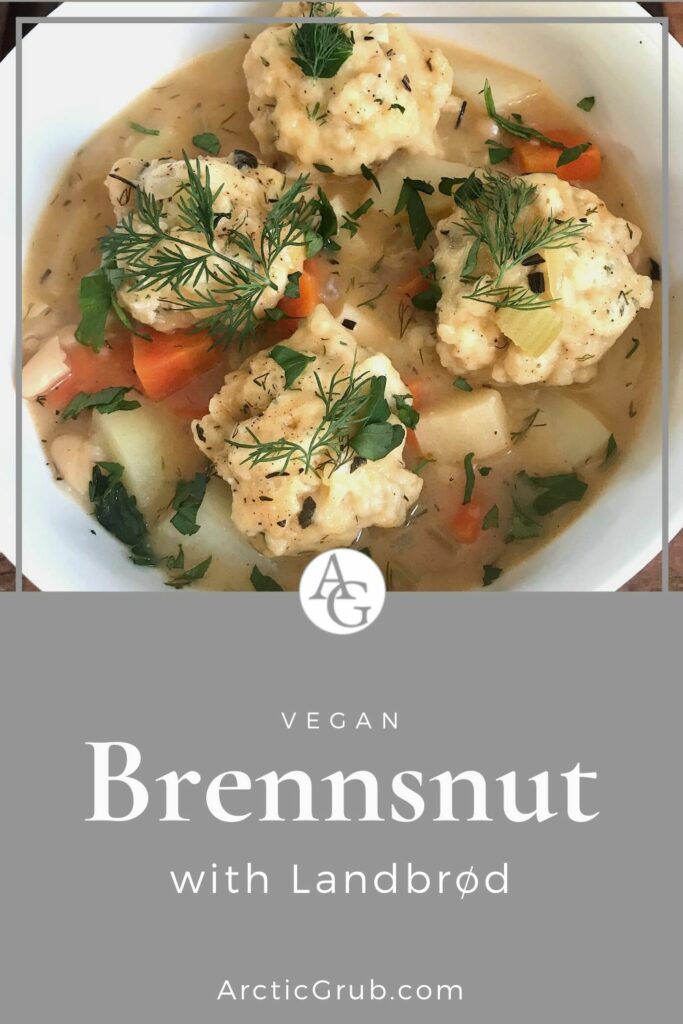
December has now passed, and I’m sure I’m not the only one who has indulged one too many times on foods I typically don’t eat every day. January is a time of restraint, in an effort to clean out our system and clean up our diet, and while today’s Norwegian food is richer than in the past, we also have examples of healthy dishes that have survived the times.
January was historically a month when most people had little to no dispensable cash, due to the extravagant month of December when every little “extra” was used. What was left, however, may have been the bones of the mutton ribs (fenalår) eaten at the holiday. Making stock from these bones provided a flavorful broth used to create a variety of soups and stews and as a base for other meals.
I felt like sharing with you a recipe for a popular soup called brennsnut, which translates into “burnt snout,” because the soup is to be served piping hot. This is a specialty from my region of Sunnmøre, and every household has at one time or another incorporated this dish into their weekly dinner menu.
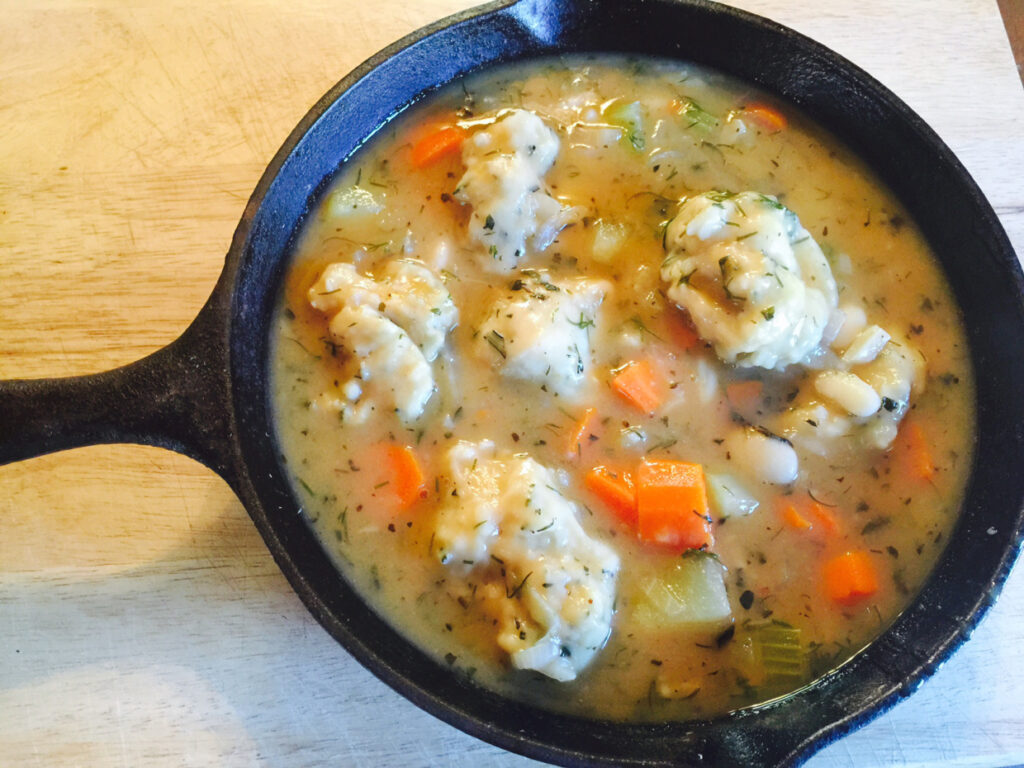
Brennsnut was considered a “leftover feast” with recognizable flavors of Christmas. Common ingredients in the soup include carrots, potatoes, leeks, rutabaga, and leftover sausage and meat. It is also important to make enough of this to feed the whole neighborhood!
The soup tastes even better the next day, and it also freezes well so you can make a double batch to pull out whenever you desire a quick and healthy dinner.
Brennsnut is a perfect example of a simple, heartwarming meal that typically finds its way onto the Norwegian table on a weekday. This soup truly warms the soul and has the taste of home.
As I opted out of eating meats a few years back, I was inspired to create some vegetarian dill dumplings that add a delightful richness to the soup.
Additionally, I find that I can easily replicate a delicious broth by either using broth from dehydrated mushrooms, making my own vegetable stock, or buying a good quality organic stock. I season it up with dried and fresh herbs, as well as other spices that add depth of flavor. This, to me, is much healthier than including meat, especially since most people will have gorged on meat for the entire month of December, and my January is a period of eating lighter and cleansing the system.
I’ve also eliminated any type of butter and limited the amount of oil, making this a super healthy, yet flavorful dish to include in your repertoire. You can use any and all vegetables you have leftover, although traditionally this soup is heavy on root vegetables, as that is what is typically widely available in Norway during the cold winter months.
If you don’t feel like going to the trouble of making the dumplings, adding a cup of barley with another two cups of vegetable stock to the soup, in the beginning, will work fine as well.
In my house, brennsnut was served with the regional specialty flatbrød. Alternatively, you can make the special Norwegian “landbrød,” for which I’ve included a recipe.
BRENNSNUT
6 Yukon Gold potatoes, peeled and cubed
2 carrots, peeled and sliced thin
1 Vidalia onion, peeled and diced
2 celery stalks, diced
2 tsp dried thyme
2 tsp dried basil
1 tsp garlic powder
1 medium rutabaga or kohlrabi, peeled and cubed
1 small celery root (celeriac), peeled and cubed
1 medium leek, sliced thin
3 quarts homemade or store-bought vegetable stock
1 quart mushroom stock* (Optional—pour hot water over 1 cup of mixed mushrooms and leave for 30 min. to 1 hour. Strain the liquid through a fine sieve and reserve. Chop up mushrooms and add to the soup for an extra rich flavor.)
dill dumplings
1 tbsp. kosher or sea salt
Dill Dumplings:
1 1/2 cups all-purpose flour
2 tsp baking powder
2 tbsp fresh dill, finely chopped
1-2 tsp kosher or sea salt
3/4 cup unsweetened plant-based milk (like oat or cashew)
2 tbsp olive oil
To make dumplings:
In a large bowl, sift together the flour, baking powder, and salt. Fold in the fresh dill. Combine the milk and olive oil and add to the dry mixture, using a wooden spoon to form a wet dough.
Form the dumplings using a large spoon; you should get about 12 or so dumplings out of this.
To assemble and make soup:
In a large soup pot, add a little vegetable stock over medium-high heat, and add in onion, celery stalks, and carrots. Add the dried thyme, basil, and garlic powder, season with a little kosher salt, and sauté for about 4-5 minutes until fragrant and slightly tender.
Add in the vegetable and optional mushroom stock and all the other diced vegetables. Bring to a boil and lower down to simmer and cook for about 20-30 minutes until vegetables are tender. Add in the prepared dill dumplings and cook for another 15 minutes. Serve with flatbrød or landbrød.
Landbrød
50 g fresh yeast or 4 tsp dry yeast
3 cups water
1 tbsp salt
2 3/4 lbs all-purpose flour
Mix the yeast into warm water and add in the flour. Mix in salt. Knead the dough for a long time, shape into a ball, and place it in a lightly oiled bowl.
Let rise under a towel in a warm spot for about 1 1/2-2 hours. Punch down and pour onto a floured surface, continuing to knead and shape into a big, round loaf. Let it rise once again for 45 minutes.
Preheat oven to 450°F.
Place onto a baking sheet in the oven and bake for about 10 minutes. Reduce the heat to about 400°F and bake for another hour. Turn off the oven and let the bread sit in the oven for another 15 minutes.
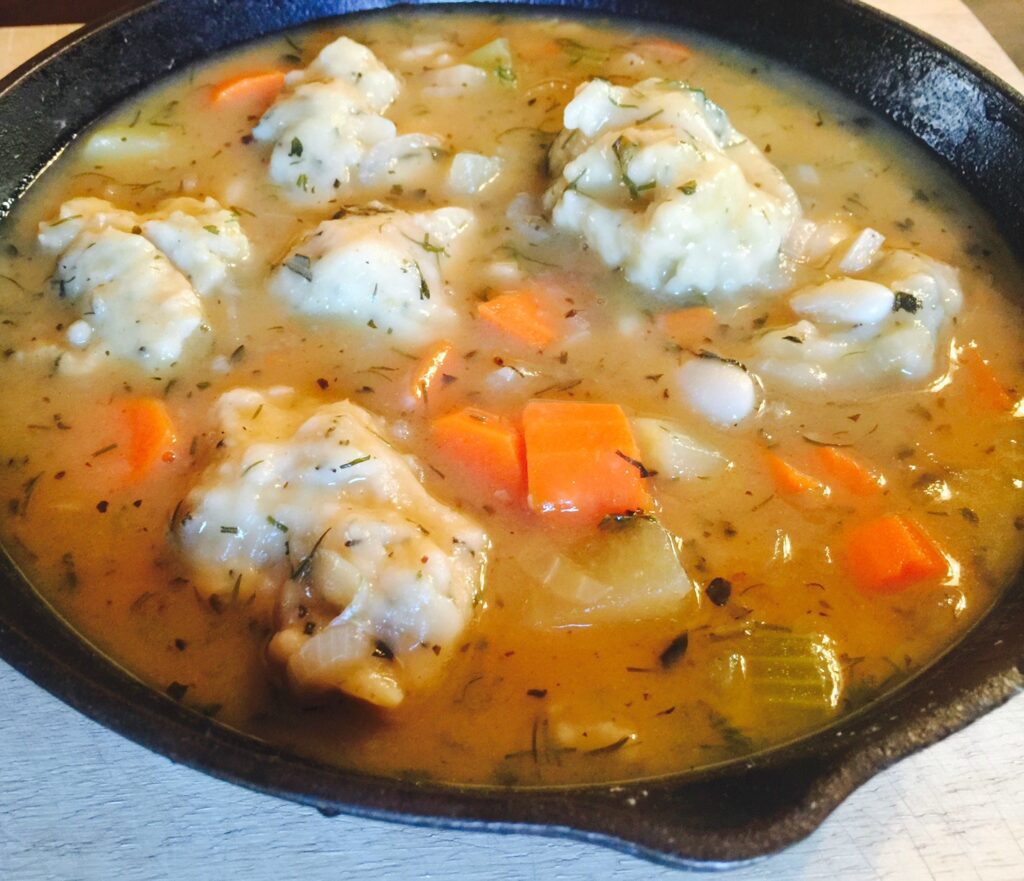

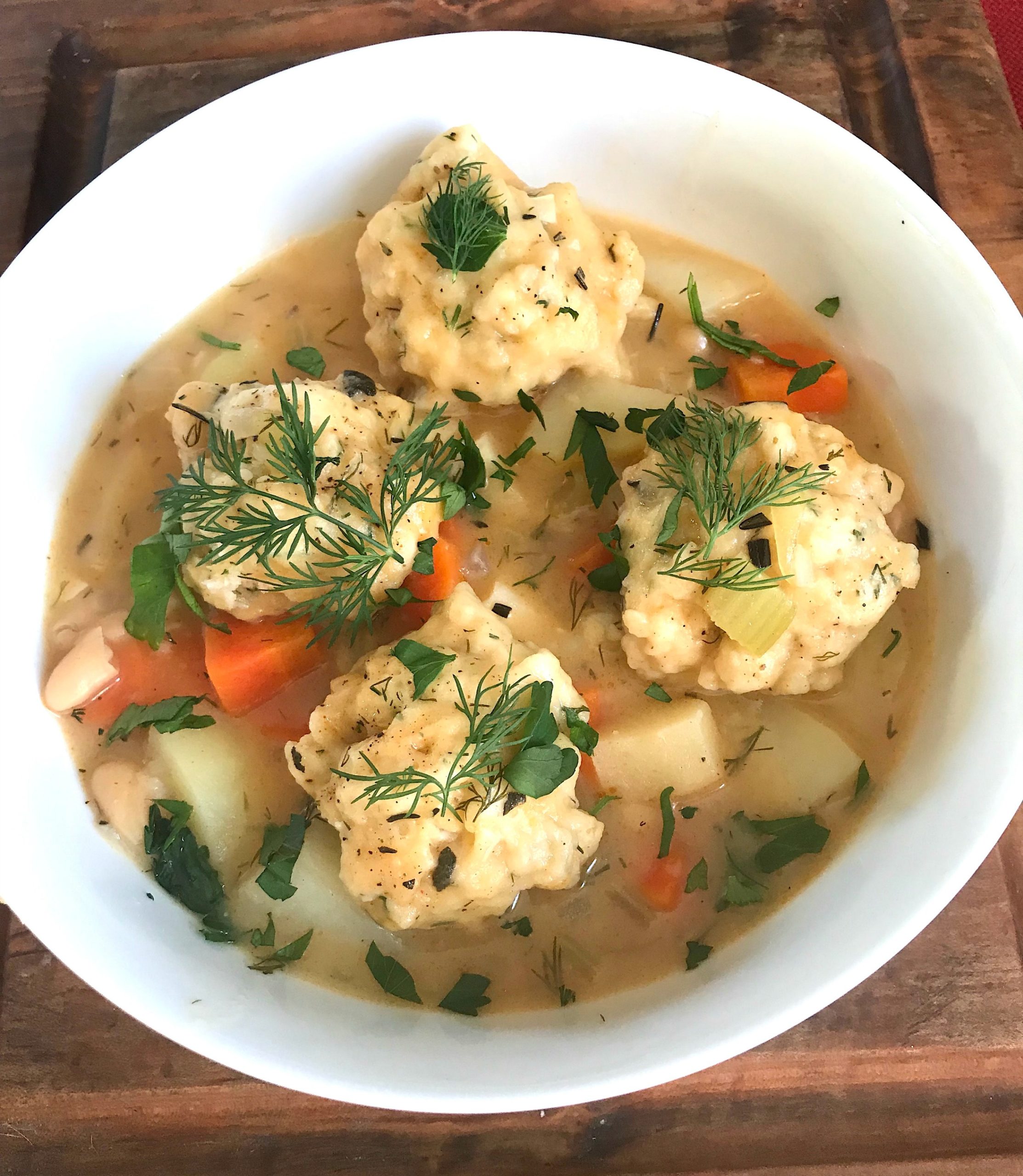
Brennsnut
Ingredients
- 6 Yukon Gold potatoes, peeled and cubed
- 2 carrots, peeled and thinly sliced
- 1 Vidalia onion, peeled and diced
- 2 celery stalks, diced
- 2 tsp dried thyme
- 2 tsp dried basil
- 1 tsp garlic powder
- 1 medium rutabaga or kohlrabi, peeled and cubed
- 1 small celery root (celeriac), peeled and cubed
- 1 medium leek, thinly sliced
- 3 quarts homemade or store-bought vegetable stock
- 1 quart mushroom stock* (Optional—pour hot water over 1 cup of mixed mushrooms and leave for 30 min. to 1 hour. Strain the liquid through a fine sieve and reserve. Chop up mushrooms and add to the soup for an extra rich flavor.)
- dill dumplings
- 1 tbsp. kosher or sea salt
Dill Dumplings:
- 1 1/2 cups all-purpose flour
- 2 tsp baking powder
- 2 tbsp fresh dill, finely chopped
- 1-2 tsp kosher or sea salt
- 3/4 cup unsweetened plant-based milk (like oat or cashew)
- 2 tbsp olive oil
Landbrød:
- 50 g fresh yeast or 4 tsp dry yeast
- 3 cups water
- 1 tbsp salt
- 2 3/4 lbs all-purpose flour
Instructions
To make dumplings:
- In a large bowl, sift together the flour, baking powder, and salt. Fold in the fresh dill. Combine the milk and olive oil and add to the dry mixture, using a wooden spoon to form a wet dough.
- Form the dumplings using a large spoon; you should get about 12 or so dumplings out of this.
To assemble and make soup:
- In a large soup pot, add a little vegetable stock over medium-high heat, and add in onion, celery stalks, and carrots. Add the dried thyme, basil, and garlic powder, season with a little kosher salt, and sauté for about 4-5 minutes until fragrant and slightly tender.
- Add in the vegetable and optional mushroom stock and all the other diced vegetables. Bring to a boil and lower down to simmer and cook for about 20-30 minutes until vegetables are tender.
- Add in the prepared dill dumplings and cook for another 15 minutes. Serve with flatbrød or landbrød.
To make Landbrød:
- Mix the yeast into warm water and add in the flour. Mix in salt. Knead the dough for a long time, shape into a ball, and place it in a lightly oiled bowl. Let rise under a towel in a warm spot for about 1 1/2-2 hours.
- Punch down and pour onto a floured surface, continuing to knead and shape into a big, round loaf. Let it rise once again for 45 minutes.
- Preheat oven to 450°F.
- Place onto a baking sheet in the oven and bake for about 10 minutes. Reduce the heat to about 400°F and bake for another hour. Turn off the oven and let the bread sit in the oven for another 15 minutes.








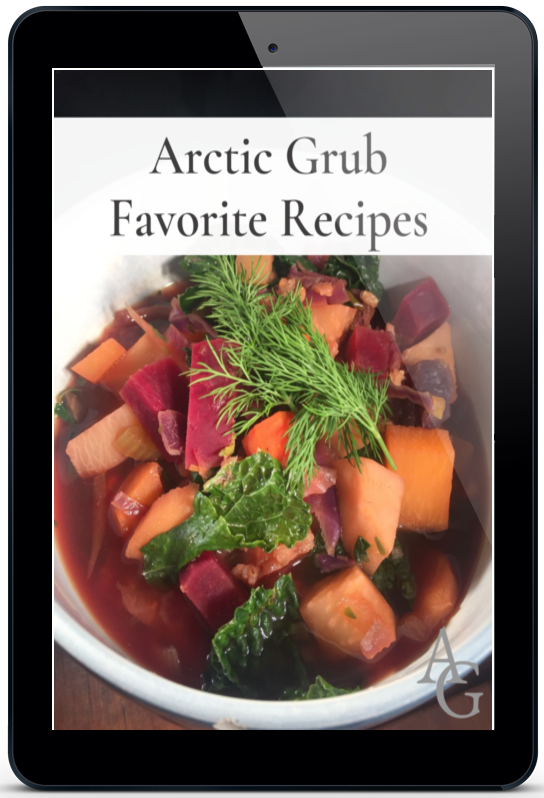
I have to try this! It’s nice to see a traditional recipe altered for vegetarians.
So happy to hear this, Elizabeth! I look forward to hearing your feedback once you’ve tried making it! Sunny 🙂
This looks very good. I’m more vegetarian than vegan but I’d love to try your recipes here. Thanks for posting them.
Hi Karen! Thanks so much for your kind comment; I hope you’ll try out my recipe, too! I really write for non-vegans to show everyone that vegan food can have flavor, texture, and equal enjoyment even if you’re a dairy, egg, or meat eater. I also mever forget I was a meat eater for 40 years and a chef cooking with meat so my specialty lies in recreating these meals to be just as satisfying. 🙂
From: Ole. Born and growing up until 12 years old in Aalesund. I loved brennsnut, but I remember cabbage and stew size meat in it. Am I off or thinking of the wrong soup. Thanks for the post I will make some.
Hi Ole! No you are not wrong in remembering brennsnut this way – brennsnut is like all other recipes, we all have different versions of it! Hope you tried your hands at making some and thanks for writing in! 🙂